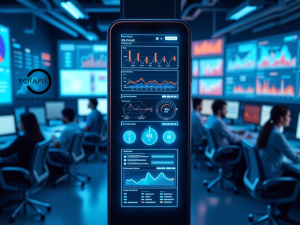Augmented Reality in E-commerce is revolutionizing the way consumers shop online, offering immersive and interactive experiences that enhance user engagement and satisfaction. As e-commerce platforms seek innovative ways to stand out, AR has emerged as a powerful tool to bridge the gap between digital and physical retail.
What Are the Fundamental Types of AR Features Used in Online Retail?
AR in e-commerce can be broadly categorized into several types, each designed to enrich the shopping experience:
- Virtual Try-Ons: Allowing customers to see how products look on them or in their space before making a purchase.
- 3D Visualizations: Providing a 360-degree view of products to explore details as if they were holding them.
- Interactive Showrooms: Enabling customers to navigate a virtual store from their devices, simulating an in-store shopping experience.
How Does AR in E-commerce Enhance the Shopping Experience?
AR enhances the e-commerce experience by:
- Increasing Confidence in Purchase Decisions: AR allows customers to preview products in a realistic setting, reducing the uncertainty that often accompanies online shopping.
- Boosting Engagement and Interactivity: AR features make shopping more engaging and fun, which can increase the time shoppers spend on a site and lead to higher conversion rates.
- Reducing Return Rates: By providing a clearer understanding of what they are buying, AR can significantly decrease the likelihood of returns due to unmet expectations.
Virtual Try-On Tools for Apparel and Accessories

Virtual try-on technology represents a significant leap forward in personalizing the online shopping journey, particularly for apparel and accessories.
What Are Virtual Try-On Tools, and How Do They Work?
Virtual try-on tools use AR technology to superimpose items onto the user’s image in real-time, allowing them to see how different products look on them through their smartphone or computer camera. These tools utilize advanced facial recognition and image processing technologies to adjust the item’s size, color, and orientation to match the user’s dimensions and movements accurately.
How Do These Tools Help Customers Visualize Clothing, Accessories, and Cosmetics?
Virtual try-ons transform the shopping experience by:
- Improving Accuracy of Fit: Shoppers can see how clothes fit and move with their body, helping them to make informed sizing choices.
- Enhancing Style Visualization: Customers can experiment with different colors and styles, seeing exactly how a product complements their aesthetic.
- Increasing Convenience: Shoppers can try on multiple items quickly without the need for a physical fitting room, making shopping convenient and time-efficient.
3D Product Visualizations and Configurators

3D product visualization is another AR feature that significantly impacts consumer behavior, offering a detailed view of the product’s features and customization options.
What Are 3D Product Visualizations, and Why Are They Important in AR E-commerce?
3D visualizations allow customers to view an online product from all angles, giving a realistic impression of texture, scale, and detail. This technology is vital for products where design and aesthetics are crucial decision factors, such as furniture, jewelry, and electronics.
How Do Product Configurators Allow Customers to Personalize Their Purchases?
Product configurators enhance the AR experience by enabling customers to customize products according to their preferences. Users can change components, colors, and features of a product and see the modifications in real-time. This not only ensures that the product meets the customer’s needs but also significantly enhances user satisfaction and loyalty by providing a personalized shopping experience.
Interactive Showroom Experiences

The rise of interactive AR showrooms is changing the way customers perceive and interact with brands online. By blending the digital and physical shopping experiences, these immersive spaces replicate in-store environments, providing an engaging way to explore products.
How Do Interactive AR Showrooms Replicate In-Store Experiences Online?
Interactive AR showrooms replicate the in-store experience by:
- Allowing Virtual Navigation: Users can move through the showroom as if they were in a physical store, browsing different sections and viewing products on virtual shelves.
- Enabling Detailed Product Exploration: Products can be inspected up close with 3D models, providing a realistic view of details like material quality, textures, and dimensions.
- Facilitating Direct Interaction: Customers can interact with virtual store assistants for guidance and recommendations, just like they would with a human assistant in a store.
What Types of Products Benefit Most from These Immersive Digital Showrooms?
AR showrooms are particularly beneficial for products that require a tactile experience or detailed inspection before purchase. These include:
- Furniture and Home Decor: Customers can see how items fit in their living space, evaluating size and style compatibility.
- Automotive and Electronics: Buyers can explore different features, configurations, and customizations in detail.
- Fashion and Accessories: Shoppers can view collections as if they were walking through a physical showroom, making it easier to understand how different pieces fit together.
AR-Based Virtual Storefronts

AR-based virtual storefronts take online shopping to the next level by providing an interactive environment where customers can explore a curated collection of products in a highly engaging way.
What Is an AR-Based Virtual Storefront, and How Does It Differ from a Traditional Online Store?
An AR-based virtual storefront is a digital space where customers can explore and engage with products as if they were in a physical store. Key differences include:
- Immersive Exploration: Products are presented in a virtual environment that mirrors an actual store layout, offering a more engaging experience than traditional category pages.
- Personalized Recommendations: Virtual assistants or bots can guide customers based on their preferences and purchase history, creating a more tailored experience.
How Do These Storefronts Encourage Customers to Explore and Engage with Products?
AR-based virtual storefronts encourage exploration and engagement through:
- Gamification Elements: Incorporating quizzes, challenges, or rewards makes shopping more enjoyable, increasing time spent in-store.
- Product Demonstrations: Customers can view interactive demos of how products work or look in real-world scenarios, making it easier to understand product value.
- Immediate Customisation and Feedback: Buyers can personalise products in real time and instantly see the results, fostering a sense of ownership and increasing purchase intent.
Guided AR Shopping and Assistance

Guided AR shopping assistance is revolutionising the e-commerce landscape by providing customers with personalised guidance that simplifies their purchasing decisions.
How Does AR-Powered Shopping Assistance Provide Personalised Guidance to Customers?
AR-powered shopping assistance offers tailored guidance in several ways:
- Virtual Shopping Assistants: These digital assistants can appear on a user’s screen to provide advice, answer questions, and assist in navigating the virtual store.
- Personalised Recommendations: By analysing a customer’s previous shopping behaviour, preferences, and real-time interactions, the AR system can suggest products that closely align with the customer’s interests.
- Visualising Fit and Functionality: AR tools can overlay products onto the customer’s environment, showing how furniture or decor will look in their home or how clothes will fit based on their body measurements.
What Types of Support and Recommendations Are Offered Through Guided AR Shopping?
Guided AR shopping can provide various types of support and recommendations, including:
- Style Suggestions: For fashion and home decor, AR assistants suggest complementary items to help customers complete a look or design theme.
- Tutorials and How-To Guides: Interactive AR tutorials can demonstrate how to use a product or make the most of its features, providing hands-on training.
- Product Comparisons: AR allows customers to visually compare similar products side by side in their environment, making it easier to choose between different brands and models.
Tailoring AR Features to Enhance E-commerce
The potential for augmented reality in e-commerce is vast, but to make the most of it, online retailers must carefully tailor AR features to meet their customers’ specific needs.
How Can Online Retailers Tailor AR Features to Meet Their Customers’ Needs?
Retailers can tailor AR features by:
- Understanding Customer Behaviour: Analyse customer data to identify shopping preferences, pain points, and browsing habits that can be addressed through AR solutions.
- Offering Flexible AR Tools: Provide tools that adapt to different customer segments, such as varying levels of AR detail for experienced vs. first-time users.
- Providing Cross-Platform Compatibility: Ensure that AR features work seamlessly across different devices, browsers, and operating systems for an inclusive shopping experience.
What Should Businesses Consider When Selecting AR Features for Their E-Commerce Platform?
Key considerations when selecting AR features include:
- Integration with Existing Systems: Ensure that AR features can integrate with the existing e-commerce platform without disrupting other functionalities.
- Ease of Use: Features should be intuitive and easy for customers to navigate without a steep learning curve.
- Scalability: Choose AR solutions that can scale wit








